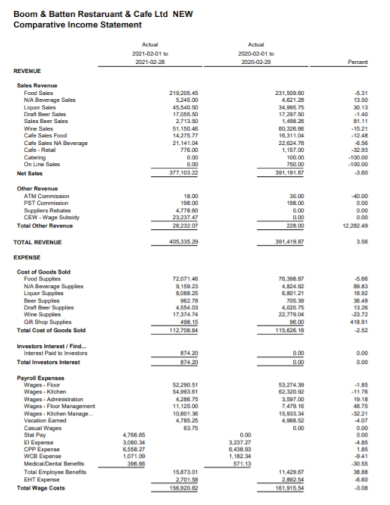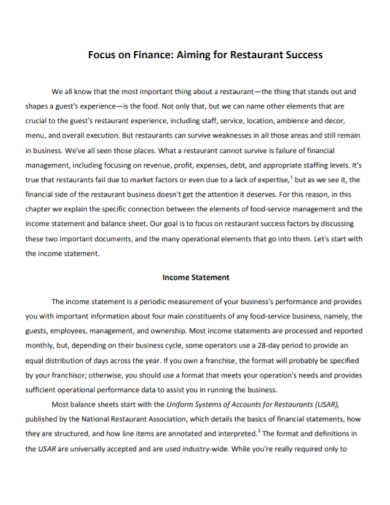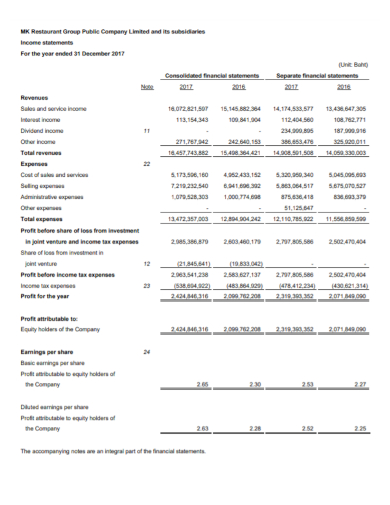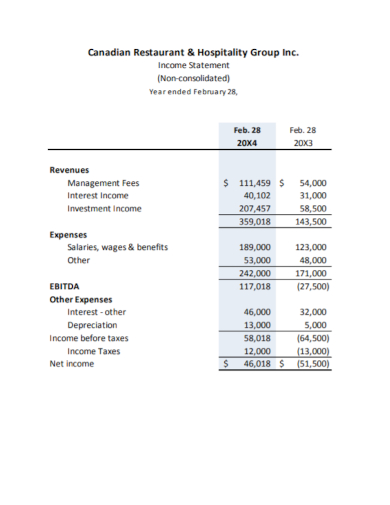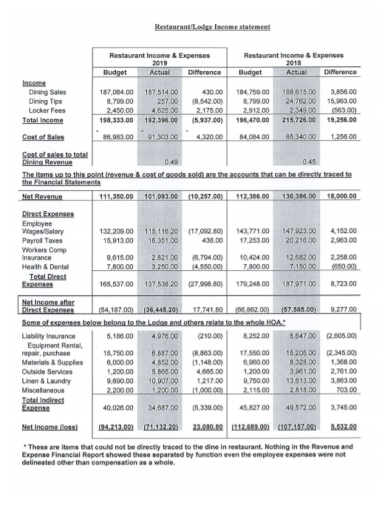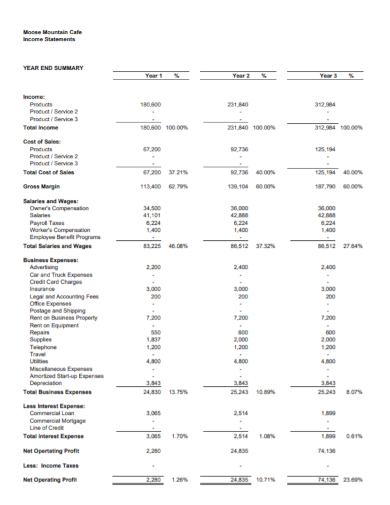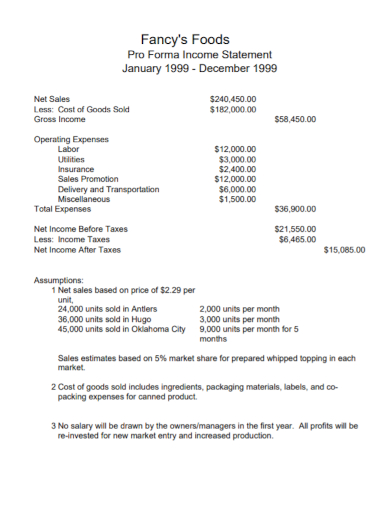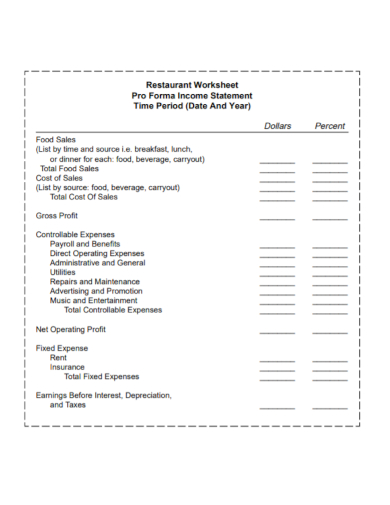An income statement is one of the basic yet important parts of running a profit-making business such as a restaurant. It is one of the backbones of what manages a company because it provides the breakdown of revenues and expenses of operations in a daily, weekly, monthly, or any time division and period of a year. In its most basic form, it is a statement that reflects and explains in numbers the costs subtracted from the sales. From that result, restaurateurs and executives will have an idea of the financial situation of their restaurants and will drive them to do the necessary actions to maintain the success or make up for their loss. What are the basic parts of a restaurant income statement? If you are just starting your own restaurant or just want to improve your management skills for your business, you can download our free Restaurant Income Statement to guide you in making your own income statement. Here are the parts of a restaurant income statement.
10+ Restaurant Income Statement Samples
1. Restaurant Income Statement Template
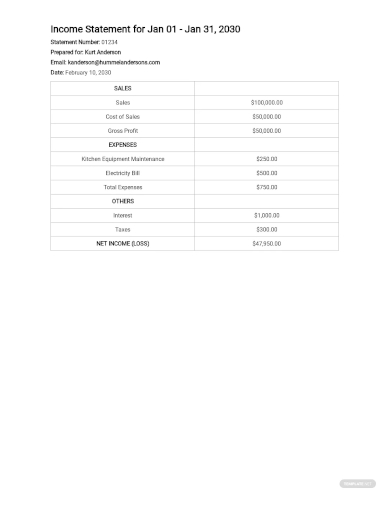
2. Restaurant Income Statement Quarterly Template
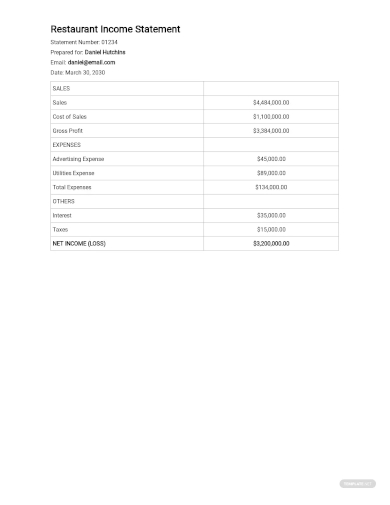
3. Restaurant Cafe Comparative Income Statement
4. Restaurant Finance Income Statement
5. Restaurant Group Subsidiaries Income Statement
6. Restaurant Hospitality Income Statement
7. Restaurant Lodge Income Statement
8. Restaurant Cafe Summary Income Statement
9. Restaurant Food Proforma Income Statement
10. Restaurant Coffee Shop Income Statement
11. Restaurant Worksheet Income Statement
Parts of a Restaurant Income Statement
1. Sales Breakdown
The profit of your restaurant is the thing that keeps you in business that must be included in your income statement. It identifies which items on the menu for a certain period of time are best-selling and those that didn’t make it to the customers’ plates. How much each item makes up the revenue is included in this part of the statement. The sales breakdown is the first step to determining the profit-making strategy for the business.
2. Costs
In this section, you are to list down the expenses of buying the goods and ingredients to prepare the foods in your menu. It includes the cost of goods sold (COGS) which is the total cost of the inventory of the foods and beverages sold over a period of time. This is done by listing each item and the corresponding cost summed up and indicated in a clear and obvious way to avoid confusion.
3. Labor Costs
It is the total amount of money subtracted from the overall profit that is allocated as payment for the services of individual workers of the restaurant. Hence, it is the salaries given to the employees and workers that make up the business. By determining the labor cost, managing the human resources aspect of the restaurant becomes easier as it is one of the bases of how many workers is needed to accomplish a certain task taking into account the restaurant’s overall revenue.
4. Operating Costs
This section of the income statement encompasses all aspects of running your restaurant and its corresponding expenses. Aside from the salaries and wages of the workers, the operating costs include daily operating expenses such as supplies, repairs, and marketing. If your restaurant is renting a space or a whole building, occupancy expenses can be included in this section. Occupancy expenses include overhead expenses, rent payment, insurance, taxes, utilities, and waste removal.
5. Net Profit or Net Loss
This is the final part of your restaurant income statement where you include the calculations of expenses and profit and how well your restaurant fared over a particular period of operating time. This is where you add up all your expenses and the different costs of maintaining your restaurant’s good condition and compare it to the total profit. If the calculations result in a positive number, it means the restaurant is thriving and is doing well. If it results in a negative number, it means that you’re spending too much while not being profitable. When this happens, this is the time that you go over your marketing strategy or other factors such as a menu, customer service, or even the location and interior design of your restaurant.
FAQs
What is a footfall?
It refers to the number of people who visit a restaurant over a course of time.
What does a margin mean in business?
It is the result of sales minus the overall goods cost.
What is a markup?
It is the amount added to the original price of a product to increase profit.
Related Posts
FREE 10+ Timeline Outline Samples in PDF
FREE 3+ Blog Outline Samples in PDF
FREE 5+ College Essay Outline Samples in PDF
FREE 10+ Script Outline Samples in PDF
FREE 10+ Character Outline Samples in PDF
FREE 10+ Podcast Outline Samples in PDF
FREE 10+ Novel Outline Samples in PDF
FREE 10+ Chapter Outline Samples in MS Word | Google Docs | Pages | PDF
FREE 10+ Autobiography Outline Samples in MS Word | PSD | AI | Publisher | Pages | Indesign | PDF
FREE 10+ Exhibition Proposal Outline Samples in MS Word | Google Docs | PDF
FREE 10+ Feasibility Study Outline Samples [ Course, Content, Engineering ]
FREE 10+ Demonstrative Speech Outline Samples in PDF | DOC
FREE 10+ Meeting Outline Samples in PDF | MS Word
FREE 5+ Sample Cover Letter Outline Templates in PDF
FREE 8+ Sample Resume Outline Templates in PDF | MS Word

